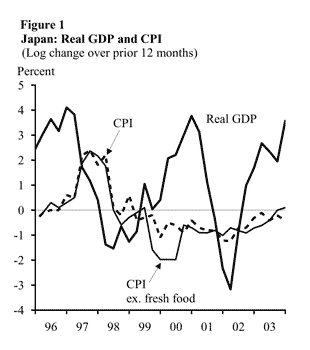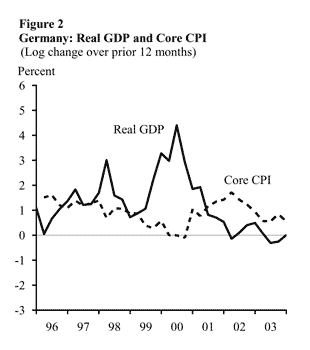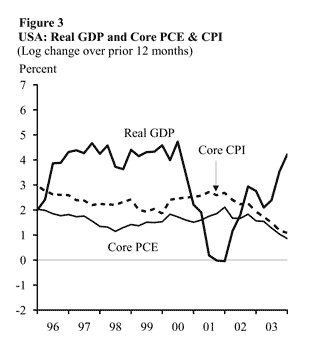Since the double-digit inflation of the 1970s, the Federal Reserve has consistently pursued the goal of price stability in the United States. And, since the second half of 2002, the year-to-year increase in the core Consumer Price Index (that is, excluding the relatively volatile food and energy components) has been below 2%, which, according to Fed Governor Bernanke, is probably the de facto equivalent of price stability (Bernanke 2003).
Since the double-digit inflation of the 1970s, the Federal Reserve has consistently pursued the goal of price stability in the United States. And, since the second half of 2002, the year-to-year increase in the core Consumer Price Index (that is, excluding the relatively volatile food and energy components) has been below 2%, which, according to Fed Governor Bernanke, is probably the de facto equivalent of price stability (Bernanke 2003).
This development in the U.S. economy inflation dynamics is unambiguously an important achievement. However, last year, as the prospects for growth remained uncertain, there were concerns that the downward tendency of inflation might continue, posing a remote, but still possible, risk that the inflation rate could fall to a level that is too low. For instance, the balance-of-risks statement issued at the close of the FOMC meeting on May 6, 2003, recognized explicitly that the probability of an unwelcome substantial fall in inflation, though minor, exceeds that of a pickup in inflation from its already low level.
This Economic Letter examines the distinct features of deflation, discusses why it is a matter of concern to the public and to policymakers in general, and looks at the recent experience of the inflation and deflation in the U.S. and other countries.
Let’s first be clear about the definition of deflation. Deflation refers not to falling prices anywhere in the economy, but to a decline in the general price level across the economy. In other words, it is a decline in the price level, not a decline in the growth rate of the price level. The latter is often referred to as “disinflation,” which means a decline in the rate of inflation.
It also is useful to be clear that, for the purposes here, one need not make a strict distinction between the low inflation and the deflation. Part of the reason is that, in reality, it is hard to distinguish between very low inflation and modest deflation. This is because inflation as measured by regular price indices is often biased upward; for instance, according to statistical analysis, the annual inflation rate as measured by core Personal Consumption Expenditure (PCE) price index is probably biased upward by about 0.5 percentage point, and the bias can be even a bit higher when measured by core Consumer Price Index (CPI). Therefore, when the measured inflation rate is below 1%, one cannot really tell for sure whether we are experiencing low inflation or modest deflation.
Another, perhaps more fundamental, reason for not making such a distinction is that, as the economy swings from low inflation to modest deflation, the dynamics of inflation and most other aspects of the economy do not change dramatically. In particular, in examining the potential costs to the economy, there is no sharp discontinuity around the switch point. Therefore, one may not need to separate these two scenarios in discussing the causes or the implications of deflation.



In thinking of deflation, one should keep in mind that the term describes only the dynamics of the overall price level. It does not imply any specific description of real economic activity. As a matter of fact, deflation can be accompanied by a weak economy as well as a by strong economy, and the recent experience of Japan and Germany illustrate this point. Figure 1 shows that Japan experienced a contraction in real GDP accompanied by a fall in the Consumer Price Index in 1998 and early 1999. In contrast, Figure 2 illustrates that Germany experienced a deflation (or very low inflation) in 1999 and 2000, along with strong real GDP growth. Still, examples of deflation accompanied by economic strength are rarer in modern industrialized economies.
Macroeconomists generally agree that, in the long run, inflation and deflation are monetary phenomena. However, in the short run, many factors can push the economy toward deflation. One type of factor is a positive shock to supply in the economy. For instance, a positive shock to labor productivity will put downward pressure on prices. This occurs because nominal wages and salaries are slow to adjust to unexpected changes in output per hour. With output per hour rising faster than wages, unit labor costs decline. In competitive markets, this will induce firms to reduce their product prices, and the increase in general price level will tend to slow. For instance, as shown in Figure 3, the productivity surge in the U.S. in the late 1990s boosted real GDP growth while keeping the inflation rate on a downward trajectory (“disinflation”). Another example of a positive supply shock might be a decline in the price of oil. It is possible that if the positive supply shocks were prolonged, the inflation rate would probably continue to fall and could eventually lead to deflation, even while, at the same time, economic growth might be quite satisfactory.
Deflation also can be induced by negative shocks to aggregate demand. A negative shock that persistently affects aggregate spending, such as a continued decline in consumer confidence, will increase slack in labor and product markets. High unemployment and low capacity utilization will then cause the inflation rate to decrease gradually over time, until the economy returns to full employment.
Deflation is essentially just the opposite of inflation. Therefore, the reasons that inflation is costly will tend to apply also to deflation. For instance, like an unexpected inflation, an unexpected deflation will tend to redistribute wealth between borrowers and lenders when debt contracts are not indexed. Deflation also degrades the efficiency of the price system as resource allocator and adds complexity to people’s and firms’ decisionmaking. It also distorts the tax treatment of capital because taxation generally uses nominal income rather than real income as the tax base.
When the economy is in a prolonged recession, a deflation can be even more costly than an inflation, as couple of factors may come into play and worsen the situation. First, if the short-term nominal interest rate is already low, declining inflation and the Federal Reserve policy actions to stimulate the economy may eventually push it toward zero. Because the nominal interest rate cannot be reduced further, worsening deflation would raise the real interest rate, effectively tightening monetary policy and discouraging consumption and investment. Theoretically it may even further reduce aggregate demand and the general price level, and continue the downward spiral. Reifschneider and Williams (2000) describe this situation as a “deflation trap” for monetary policymakers, because the conventional open-market operations alone will no longer be able to stabilize the economy.
Second, the labor market adjustment may be more difficult. During a recession, unemployment is typically higher, as the demand for workers is weak. In order to boost employment, nominal wages need to fall. But workers are typically very resistant to accepting wage reductions in nominal terms. Therefore real wages tend not to decline to the level required to “clear the market,” and, as a result the job losses in this situation might be greater than in a modest inflation. This may prolong the recession on several counts. It could affect factors like consumer confidence, thereby weakening aggregate demand. It also could discourage firms from increasing employment, given that product prices and profit margins are shrinking.
The situation could get even worse if the financial sector were fragile. As Bernanke (2003) pointed out, if the balance sheets of households and the corporate sector are in poor condition and if banks are undercapitalized and heavily burdened with nonperforming loans, deflation would increase the real burden of servicing these debts, increasing the amount of nonperforming loans and worsening the balance sheets of both the corporate and the financial sector. This may “exacerbate financial distress and cause further deterioration in the functioning of the financial markets.” (Bernanke 2003) This process of “debt inflation” played an important role in the U.S. deflation and depression in 1930s and it probably also played a role in contemporary Japan.
Tao Wu
Economist
References
[URL accessed March 2004.]
Bernanke, Ben S. 2003. “An Unwelcome Fall in Inflation?” Remarks before the Economics Roundtable, University of California, San Diego, La Jolla (July 23).
http://www.federalreserve.gov/boarddocs/speeches/2003/20030723/default.htm
Reifschneider, David, and John C. Williams. 2000. “Three Lessons for Monetary Policy in a Low-Inflation Era.” Journal of Money, Credit, and Banking 32(4).
Opinions expressed in FRBSF Economic Letter do not necessarily reflect the views of the management of the Federal Reserve Bank of San Francisco or of the Board of Governors of the Federal Reserve System. This publication is edited by Anita Todd and Karen Barnes. Permission to reprint portions of articles or whole articles must be obtained in writing. Please send editorial comments and requests for reprint permission to research.library@sf.frb.org